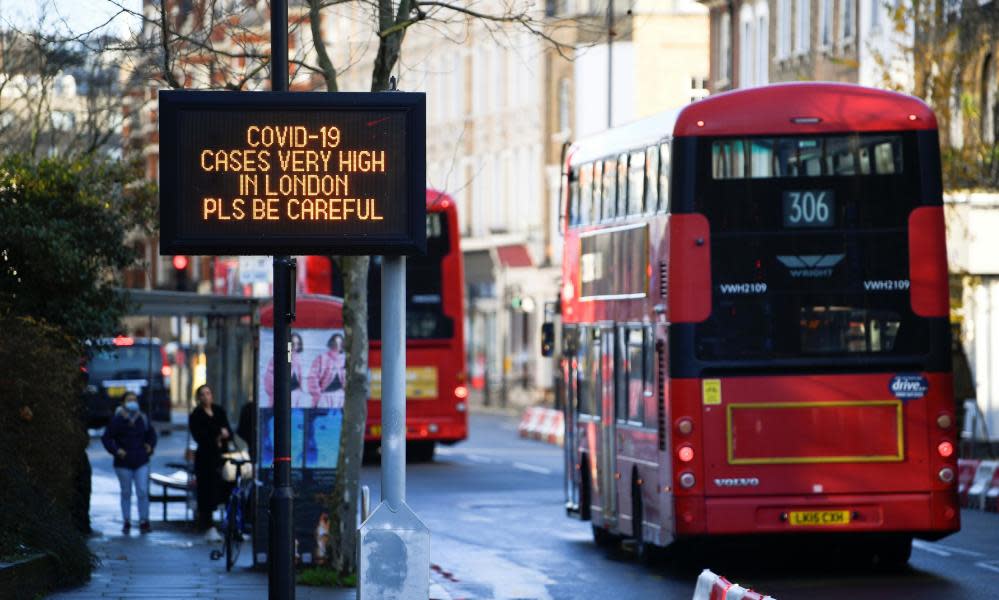Covid tier 4: what are the new rules for London and south-east England?

Boris Johnson has announced new tier 4 restrictions for London, the south-east and east of England, amid a surge in Covid-19 cases and alarm about a new strain of coronavirus spreading rapidly in the region.
What does tier 4 mean?
Under tier 4 restrictions, non-essential shops, hairdressers, and leisure and entertainment venues must close, with a new “stay at home” message introduced.
People who need to travel for education or childcare are exempt, and exercise is unlimited. Where people cannot work from home, they will still be able to travel to work.
Under the measures, households are not allowed to mix, but one person is allowed to meet with one other person outside in a public space. Support bubbles and those meeting for childcare are exempt.
Those who are deemed clinically extremely vulnerable should not go to work and should limit time outside of their homes.
Tier 4 residents must not stay overnight away from home, and cannot travel abroad.
Watch: What are the new Christmas rules?
What does this mean for Christmas?
In London and the south-east, people must stay at home over Christmas and must not meet up with other households. One resident could meet up with another one person for a walk, but not a whole household of people.
In the rest of England, the window for multiple households meeting has been reduced from a five-day window between 23 and 27 to just Christmas Day.
What can I do in each tier?
People in all tiers are advised to stay local, and “think carefully” about whether they needed to travel abroad. In all tiers, your restrictions follow you. For example, if you live in a tier 3 area, you must continue to follow tier 3 rules even when you travel to a tier 1 or tier 2 area.
You can find out which tier you live in here.
Tier 3
Non-essential shops, gyms, hairdressers and other personal care businesses can open. Places of worship can open and weddings are permitted. However, hospitality venues must close, with the exception of delivery and takeaway services.
Everyone who can work from home should do so, but you can travel within your area for work. You can also travel for reasons including education, parent and toddler groups, and to provide care or medical assistance, but you should avoid travelling outside your area and reduce the number of journeys you make wherever possible.
People must not socially meet those they don’t live with for social reasons, unless they are in a support bubble, except at a small number of outdoor locations including such as parks or beaches. There, you cannot socialise in groups of more than six.
Outdoor sports and amateur team sports can continue in all tiers, but in tier 3, spectators cannot watch sport.
You can read more on the tier 3 regulations, including the full list of exemptions, here.
Tier 2
Non-essential shops can open, as can gyms, hairdressers and other personal care businesses. Places of worship can open and weddings are allowed within local restrictions.
People living in tier 2 areas are not allowed to meet with people they don’t live with indoors, unless they are in a support bubble. Outside, including private gardens, you can only meet in groups of six people.
Everyone who can work from home should do so, but you can travel within your area for work. You can also travel for education and to provide care or medical assistance, but should only make journeys if they are essential.
You should avoid travel to or overnight stays in tier 3 areas unless it is strictly necessarily.
Hospitality venues can stay open, but only if they serve a substantial meal. The venues must take last orders at 10pm, and shut at 11pm. Pubs and bars which don’t serve “substantial” food must close altogether. Indoor entertainment venues, such as cinemas, casinos and bowling alleys, can open, but must close at 11pm.
However, you must not mix with anyone who is not part of your household or support bubble when you are indoors.
In tier 2, you can watch sports, but social distancing is in place and crowds are limited. Stadiums can fill 50% of the capacity or host 2,000 people – whichever is smaller – outdoors, or 1,000 people indoors.
You can read more on the tier 2 regulations, including the full list of exemptions, here.
Tier 1
Tier 1 is the lowest level of restrictions, and the only tier where you can meet people you don’t live with indoors and outdoors - both in groups of up to six.
Hospitality venues including museums, cinemas and pubs can stay open, but last orders must be made by 10pm and the venues must close at 11pm. Only table service can be used, and you must not mix in groups larger than six, unless you all live together.
People are encouraged to work from home where possible and to reduce their travel.
Residents in tier 1 areas are allowed to watch sport, but numbers are limited and social distancing must be in place. Outdoor stadiums can have 50% of capacity or 4,000 people, whichever is smaller. Indoors, the maximum capacity is 1,000.
You can read more on the tier 2 regulations, including the full list of exemptions, here.
How long will the measures last?
All areas in the south-east of England currently under tier 3 measures, including London, moved into tier 4 on Sunday. The health secretary, Matt Hancock, has said that these restrictions are likely to last for months, until the vaccine has been rolled out across the UK. The measures will be reviewed on 30 December, as part of a wider review of tier restrictions.
Watch: 2020 - the year of the pandemic

 Yahoo News
Yahoo News 
